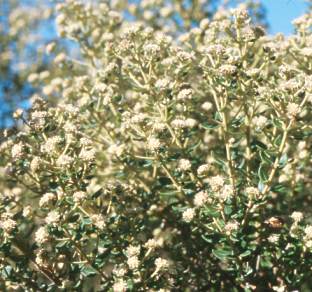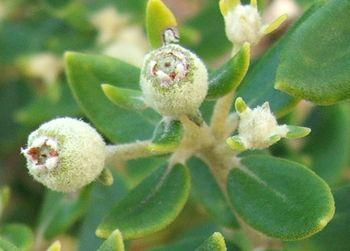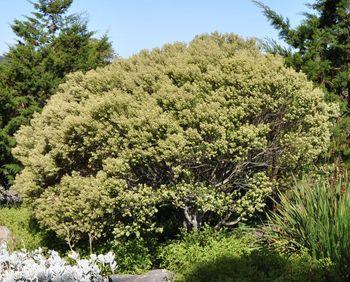Phylica buxifolia
Phylica buxifolia L.
Family: Rhamnaceae
Common names: box-leaf phylica, box hard-leaf (Eng.); bukshardeblaar (Afr.)
SA Tree No: 453.1
Introduction
This compact rounded shrub or small tree makes a good background or screening plant and should find a place in indigenous gardens near the coast, especially as it is wind-resistant.

Description
Description
This is a dense shrub or small tree, growing to about 4 m high. Twigs are hairy and buff-coloured. The leaves are small, 15-25 mm long, ovate to elliptic, with inrolled margins, and well spaced up the branchlets. They are often widest at the base and taper to a point. The leaf upper surface is dark green and rough, the lower surface covered with fine light-coloured hairs.

The velvety white flowers are in small, branched heads in the axils of the leaves and at the ends of the branches. It is in full flower in autumn, winter and early spring (from April to August), when the bushes give off a strong fragrance.

Flowers are followed by fruits which are velvety capsules about 13 mm in length.

Conservation Status
Status
Least Concern (LC), Phylica buxifolia is not threatened.
Distribution and habitat
Distribution description
The genus is confined to Africa, Madagascar and the south Atlantic Islands. Most species are endemic to the south-western parts of the Cape Province, where many are restricted to small areas.
Phylica buxifolia is endemic to the area from the Cape Peninsula (Table Mountain) to Caledon, and grows on the lower mountain slopes, often near the sea and in rocky places.

Derivation of name and historical aspects
History
The genus name Phylica is based on the Greek phyllikos which means leafy. The specific name refers to the resemblance of the leaves to those of Buxus sempervirens, the common box.
There are about 150 species in this genus. Most are shrubs with only 2 species in South Africa, Phylica buxifolia and P. paniculata, that grow to the size of small trees. Other species covered in this series include P. ericoides, P. pubescens and P. gnidioides.
Growing Phylica buxifolia
Grow
Seed can be harvested in early summer (November and December). It is best grown from seed sown in late summer to autumn (March and April) into a sandy, well-drained medium.
Phylica buxifolia makes an attractive, informal hedge, but can also be lightly clipped. In flower it is an attractive addition to cut bunches of fynbos flowers, acting as a long-lasting Cape Green (plants used to complement the more showy flowers such as proteas in bunches of Cape cut flowers). This is a good plant for fynbos and Mediterranean gardens, which receive winter rainfall. It may require watering in winter if grown in a summer-rainfall zone. Frost hardiness is unknown.
References
- PALMER, E. & PITMAN, N. 1972. Trees of southern Africa. Balkema, Cape Town.
- GOLDBLATT, P. & MANNING, J. 2000. Cape plants. A conspectus of the Cape flora of South Africa. Strelitzia 9. National Botanical Institute, Cape Town & Missouri Botanical Gardens.
Credits
Berenice Carolus
Harold Porter National Botanical Garden
November 2002 (updated June 2018)
Plant Attributes:
Plant Type: Shrub, Tree
SA Distribution: Western Cape
Soil type: Sandy, Loam
Flowering season: Autumn, Winter
PH: Acid
Flower colour: Cream
Aspect: Full Sun
Gardening skill: Easy
Special Features:
Horticultural zones










Rate this article
Article well written and informative
Rate this plant
Is this an interesting plant?
Login to add your Comment
Back to topNot registered yet? Click here to register.